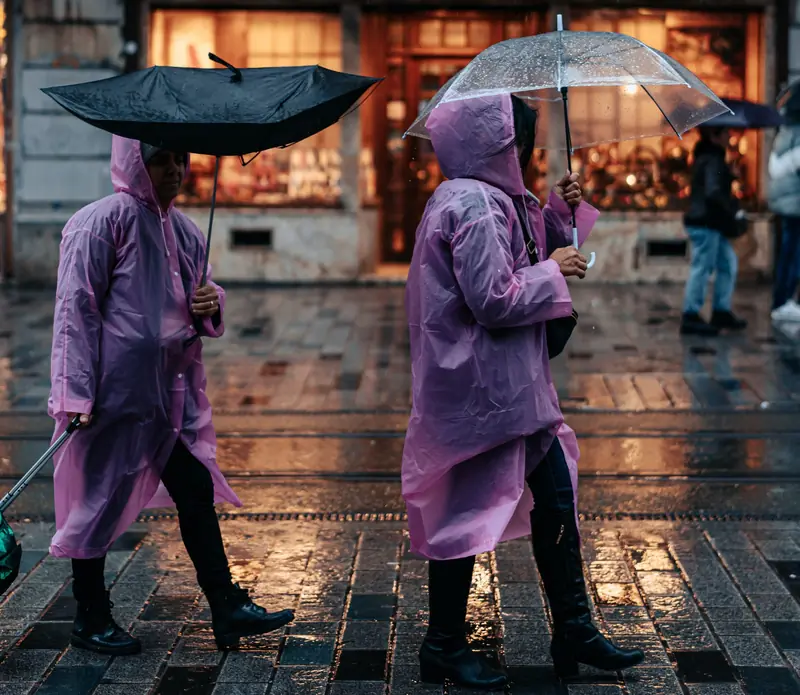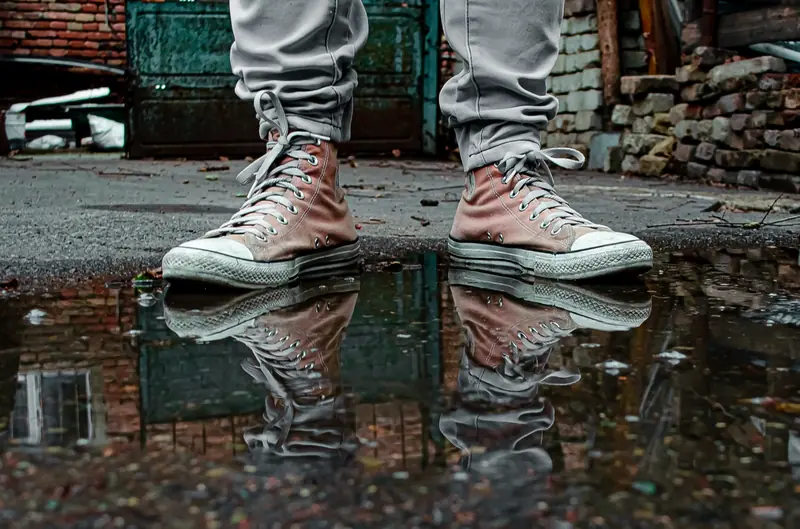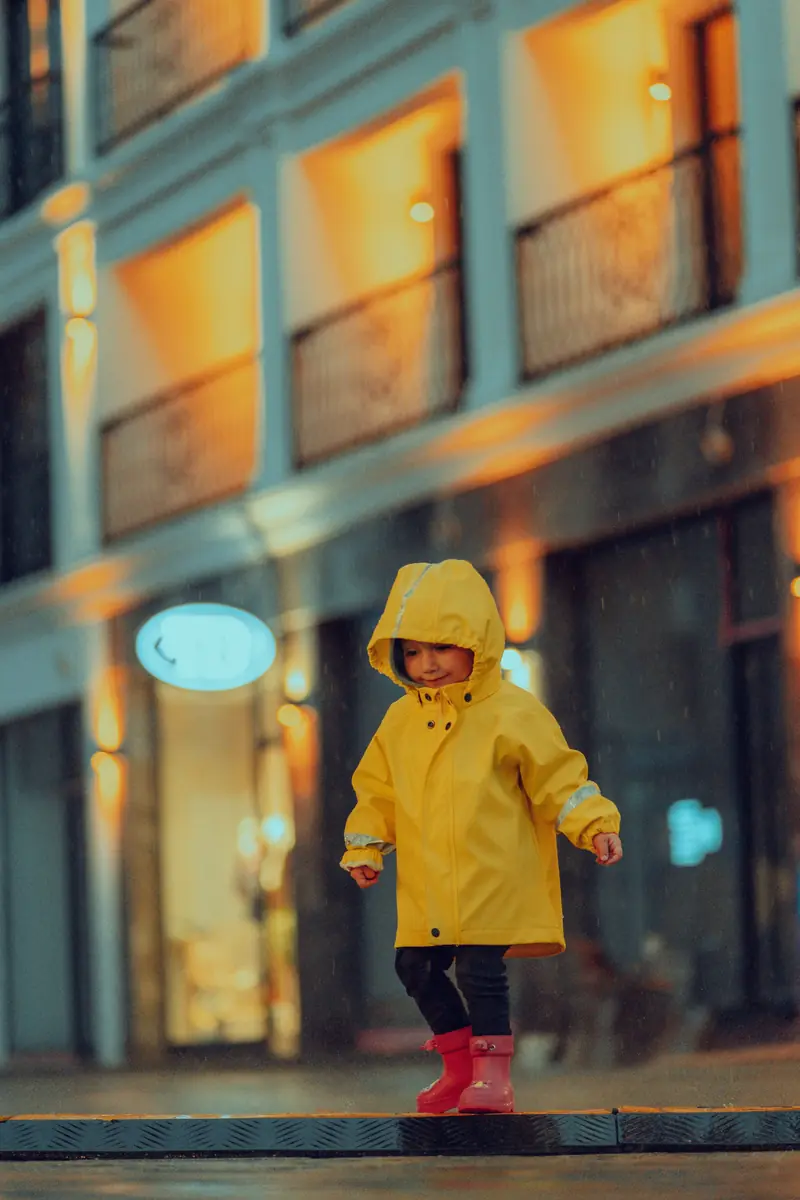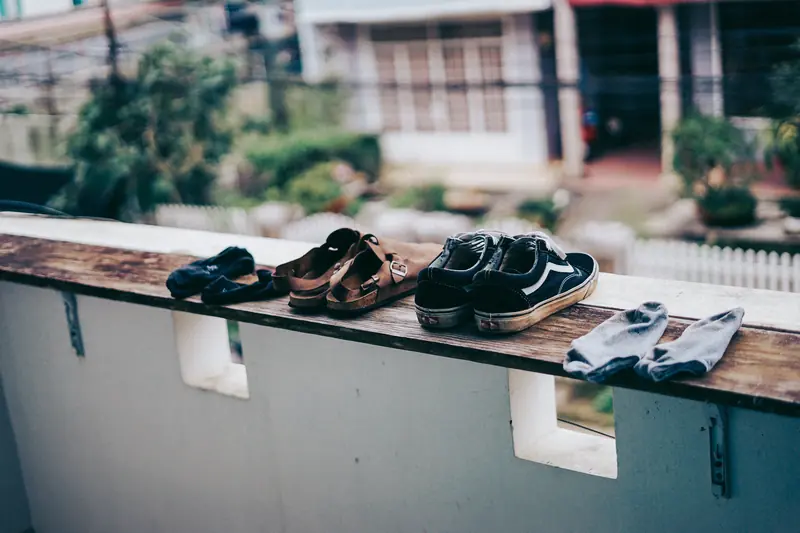
To avoid catching a cold and to quickly dry your shoes, you can use water-repellent spray, castor oil, alcohol, wax, paraffin, petroleum jelly, and a hairdryer. HouseWife has gathered popular hacks for those “wet” days.
The Dangers of Getting Wet
Unpredictable weather and puddles left from yesterday’s snowdrifts add discomfort due to wet shoes. Wet feet cool down faster, leading to a weakened immune system. Cold temperatures can impair the function of certain immune cells, allowing viruses to thrive and multiply. Therefore, keeping your feet dry during a thaw is essential to prevent catching a cold. It’s also crucial to consider how to protect your shoes from water, as there’s a second danger: fungal infections. The risk of developing fungus is particularly high for those who wear tight shoes that don’t breathe well and get wet. For the “wet” season, you need shoes and socks made from waterproof materials, as well as spare dry socks.

Waterproof Socks
This accessory minimizes the risk of wet feet, even if your shoes are inadequate. These products feature a special water-repellent membrane that allows your feet to “breathe.” Socks designed for wet weather may contain merino wool, which absorbs less moisture compared to other wool socks. On the other hand, cotton socks are not the best choice during puddle season, as they quickly soak up moisture, promoting the growth of fungi and bacteria. This can lead to unpleasant odors. In cotton socks, your feet can get cold and sweaty. It’s essential to change socks daily during the “wet” season. Don’t forget to change or wash your insoles as well.
Plastic Bags or Overshoes
An alternative to waterproof socks is simple plastic bags (polyethylene does not allow air and moisture vapor to pass through, while non-water-resistant cellophane “breathes”). This trick is used in combination with spare dry socks. After removing wet socks and shoes, dry your feet with a towel, put on a dry pair of socks, wrap your feet in plastic bags, and put on your shoes. This waterproof barrier will keep your feet dry until you can dry your shoes. A more convenient option is overshoes. They can usually be purchased for a few hryvnias at the nearest pharmacy. Wear overshoes over dry socks and put on your shoes before heading outside. Even in wet shoes, your feet will stay dry with this protection.
Waterproof Shoes
Only synthetic materials can be truly water-resistant. Specifically, rubber and ethylene-vinyl acetate (EVA is an example of a lightweight, flexible polymer that resembles suede). Not long ago, “archaic” rubber boots and galoshes seemed incompatible with fashion and style, but now they no longer look like an “anachronism” in the footwear market. The old “fishing boots” in khaki and models with bold embellishments have been replaced by a new generation of rubber footwear that looks almost indistinguishable from regular shoes. This is the most practical solution for “wet” weather, although it’s best not to use such shoes for everyday wear. A downside of waterproof materials is that they do not allow your feet to “breathe” and can trap sweat. Inside, such shoes should be dusted with moisture-absorbing baby powder or talcum powder during use.

Shoe Covers
This is a modern replacement for rubber boots: shoe covers are also made of rubber but are worn over your shoes. This gear is waterproof and slip-resistant, making it suitable for puddles and icy conditions. It’s a convenient way to protect your shoes not only from water but also from dirt. The compactness of rubber shoe covers is a significant advantage: they can easily fit into a woman’s handbag, so you can carry them with you.
“Tractor” Soles
Among the hacks for protecting shoes from getting wet, platform soles are a must-have for the “wet” season. The convenience of “tractor” soles in a grunge style (grunge translates to “dirt,” “disdain,” and “carelessness,” while also being a highly relevant modern fashion trend) is especially appreciated when navigating rough terrain. Sturdy boots are not only stylish but also highly practical. Footwear with high polymer soles and treads is genuinely unafraid of dirt and puddles.
Shoes That Shouldn’t Get Wet
The least suitable footwear for wet weather is leather and suede. Even new shoes made of genuine leather won’t protect your feet from getting wet: they are vulnerable to water not only at the seams and where the sole meets the upper but also across the entire surface. Natural materials are permeable to air and water. Leather quickly absorbs moisture, requiring careful cleaning and longer drying times compared to synthetic materials. Leather should not get wet, as soaking washes out the softening fats and oils, causing it to stiffen, lose shape, and become brittle. After being outside, leather shoes should not be washed but simply wiped with a damp cloth. While water resistance depends on the thickness and density of the leather, you cannot rely on leather shoes during a thaw without special treatment, which needs to be regularly reapplied. There are special products available for protecting leather shoes from water, sold alongside the footwear.
Water-Repellent Spray
Shoe stores offer customers cans of effective spray that can be applied to shoes before heading outside. This procedure is especially recommended for suede, as its fuzzy texture makes it impossible to use other water-repellent products (there are fewer treatment options for suede than for smooth leather). Before purchasing a spray, check the manufacturer and read the description. Choose a product from a reputable brand with dual functionality: the spray should not only repel water but also protect shoes from the salt that road services spread on streets in winter. You should apply the treatment several times. When the material stops absorbing the product, the shoes should be dried in a well-ventilated area. This protection will last about a month, after which you should reapply the water-repellent spray.

Wax and Paraffin
The simplest home hack for making leather waterproof is to treat the shoes with paraffin or wax. You need to gently rub it into the outer surface of the boots and evenly warm the shoes with a hairdryer for better absorption. However, do not use stearin candles: the fatty acids in their composition cannot protect leather from water. You can mix 1 teaspoon of grated paraffin with 2 tablespoons of linseed oil, melt the mixture in a water bath, and apply it to the shoes. A similarly effective mixture can be made with 5 grams of wax, 5 grams of wood resin, 50 grams of melted lard, and 250 ml of linseed oil. Leather treated with such a mixture will become both soft and waterproof.
Petroleum Jelly, Fat, and Oil
Treating shoes immediately after purchase or later with a pharmacy-grade greasy ointment is another way to make leather waterproof. Petroleum jelly creates an invisible protective layer on the shoes, preventing leaks. First, you need to rub the product into clean, dry leather with a brush, and then warm the treated areas with a hairdryer to melt the petroleum jelly and seal the pores. However, you can skip the hairdryer. If you’re worried about damaging the natural leather with this procedure, simply wipe the shoes with a dry cloth after treatment. For ongoing use, you can apply shoe cream. Instead of cream or petroleum jelly, you can treat the shoes with goose fat or castor oil. Apply a thin layer over the entire surface, including the areas where the material meets the sole and the seams.
If Your Feet Get Wet
The steps to take are as follows: change into dry shoes, massage your feet to restore circulation, and warm your feet in a hot bath or mustard foot soak. You can rub frozen feet with either a dry towel or a cloth soaked in hot water. Be sure to massage each toe. For quick warming, soak the “soles” of thin socks in alcohol or vodka (especially with pepper), put them on your feet, and then wear thick wool socks over them. This will provide an immediate influx of warmth. However, you can only “rescue” wet feet this way at home. What should you do if you arrive at work with wet feet? When changing shoes, you can rub your feet with your hands or a wool cloth. This procedure will also ensure a sudden rush of blood to your feet and activate your body’s defenses. To avoid catching a cold, it’s essential to have a spare pair of shoes and an extra set of dry socks at your workplace during puddle season.
What to Keep in Shoe Boxes
Manufacturers provide new shoes with packets of transparent silica gel balls. Silica gel is a desiccant: it absorbs moisture from the environment and protects the product in the box from getting wet before sale. Don’t throw away these packets after purchasing a pair of shoes: keep your shoes with the desiccant inside, as it will also help in case of accidental wetting.
Handy Drying Solutions
Street shoes should be removed and dried as soon as possible: for example, by placing tightly crumpled newspapers inside – porous paper absorbs moisture well (replace the newspapers with dry ones as they become wet). In outdoor conditions, you can even dry shoes using dry moss: it’s an excellent natural desiccant that effectively absorbs moisture for its own sustenance. Even ordinary kitchen products can help dry your shoes. Coffee beans, rice, sugar, heated salt, and baking soda (the latter not only absorbs moisture but also neutralizes unpleasant odors) are all good moisture absorbers. Place them in thin socks or fabric bags and insert them into your shoes. To ensure even filling, shake the shoes from time to time. You can also wrap the boots in a towel, tucking in the edge of the towel inside the shoes for stability. The fabric will absorb moisture faster than you expect.

How a Shoe Dryer Works
When you come in from outside, wipe your shoes dry and dry them using a shoe dryer. A special device is designed for safely drying wet shoes. An electric dryer extends the lifespan of your shoes by warming them from the inside: this does not harm the elasticity of the leather. Shoe dryers can operate for over 8 hours continuously. This is important because leather products take a long time to dry: sneakers, for example, can take about 20 hours. And while you should never leave an electric device unattended, compared to other drying options, a shoe dryer is the most acceptable.
A Safe Alternative
If you don’t have a special shoe dryer, use a fan or other household appliances. Specifically, you can blow air into the shoes using a hairdryer on the cool setting or a vacuum cleaner in blowing mode: direct the hose without a nozzle into the shaft of the boot or inside the shoe. This method will take about half an hour to dry a pair of shoes. A “warm floor” is considered a safe place to dry wet shoes: they will completely dry in 12 hours. The optimal method is natural drying in a warm, well-ventilated area, such as on a shaded balcony.
What Not to Do
It’s best to dry only laces and wet insoles on a radiator (always remove them from the shoes during drying). Also, before drying, you should pull out the “tongue” from boots and sneakers. It is strictly forbidden to dry shoes (especially leather) near heating appliances or in direct sunlight. Never use a heater, radiator, or towel dryer to dry wet boots and shoes. High temperatures can quickly deform footwear. Such barbaric treatment can lead to creases, cracks, delamination, and separation of the sole. Take care of your shoes, and they will help protect your health in slush and bad weather!
